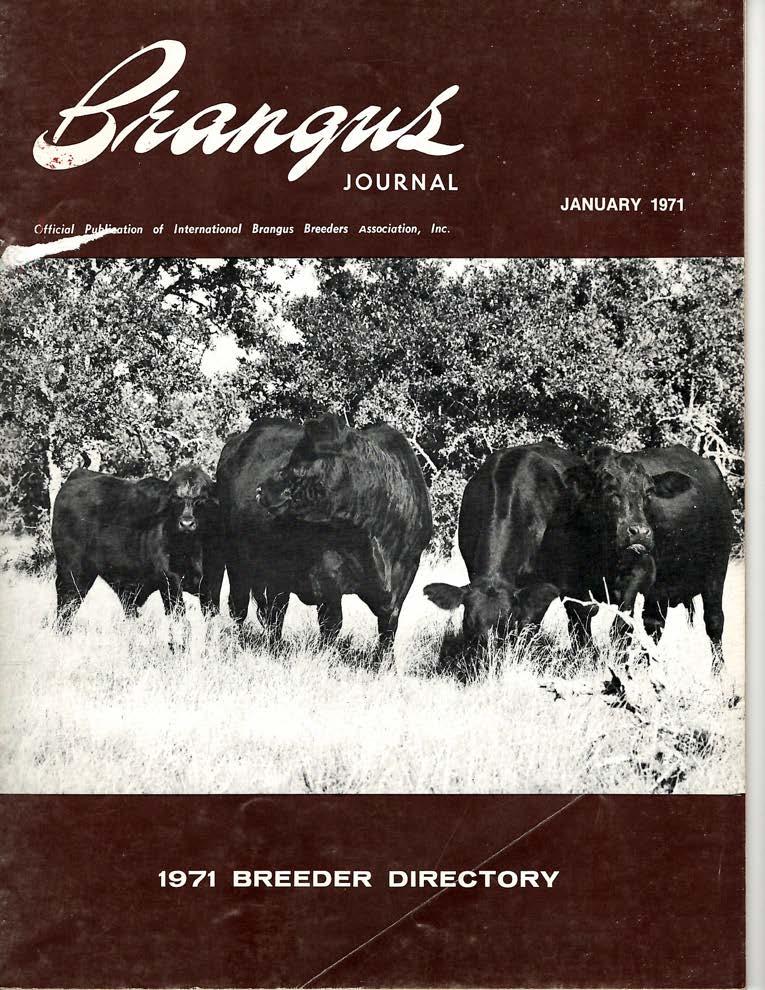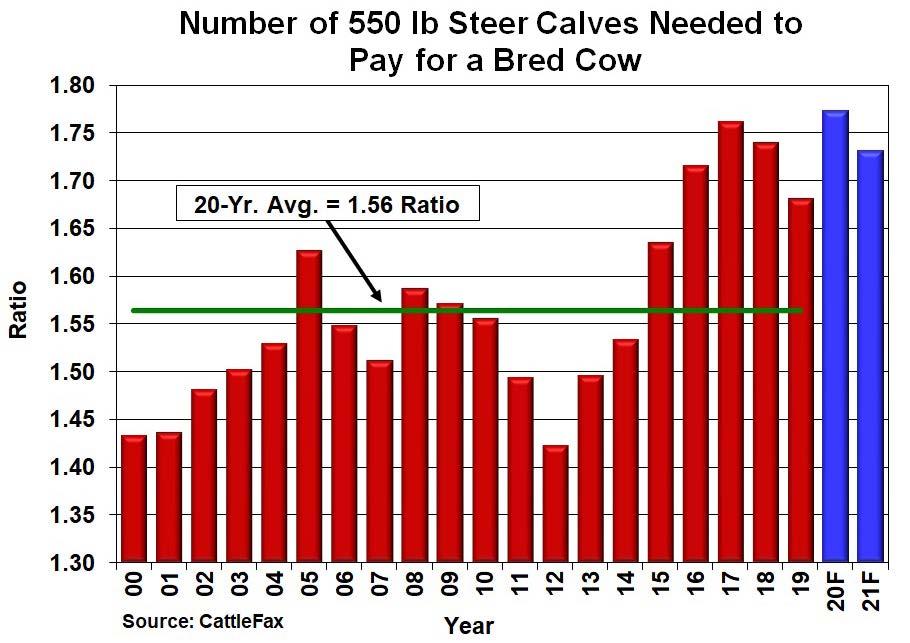
11 minute read
CATTLEFAX TRENDS
FEMALE MARKET IN THE NEXT CYCLE
The IBBA is proud to bring you the CattleFax Trends Publication. Look for this article each month in the Brangus Journal and Frontline Beef Producer. If you would like to learn more about CattleFax, please go to www.cattlefax.com.
In last month’s article the long-term outlook for the calf market was discussed. To summarize, a lot of factors are pointing to 2020 being the cycle lows, on an annual basis. From here, prices should trend higher into the middle of the decade as the cowherd endures a modest liquidation for another two or three years. Consequently, smaller calf crops should support prices and improve cow-calf producers’ leverage position to ultimately increase profitability. As margins grow, operations will be incentivized to expand, which in turn will strengthen demand for females. These trends were very prominent at the last cycle highs, and there is no reason to expect anything different at the next peak.
Two major variables that influence the female market is profitability and producers’ calf market outlook. The historical relationship between female and calf prices supports that statement. From 1980 to October 2020, monthly bred female and calf values are nearly 99% correlated. Available grazing resources can also be added to the list of factors that impact cow prices; however, it is very difficult to predict rainfall amounts six months away, let alone five years from now. Assuming Mother Nature has provided ample resources, U.S. average bred cow prices could increase at least $200 to $300 per head over the next three to four years.
The CattleFax U.S. average bred cow price is on track to average about $1,560 per head in 2020, while the U.S. 550-pound steer price should average roughly $160/cwt or $880 per head. This equates to a 1.77 ratio for the number of 550-pound steers needed to pay for a running age bred cow. The next highest ratio is 1.76 in 2017. Even though this year’s ratio could end as a new record, it would not be out of line relative to the last five years. Since calves averaged over $240/ cwt in 2014, the female-to-calf ratio has remained elevated in a range of 1.64 to 1.76, compared to the 20-year average of 1.56. CattleFax’s most recent 2021 outlook projects calves to im-prove $8/cwt and bred female prices to increase about $40, to $1,600 per head, on average, which equates to a 1.73 ratio.
Since the mid-1970s, the ratio trends lower, in general, during the contraction phase of the cattle cycle. Although, the average level of the ratio has increased each of the last three contraction phases. The beef cowherd is expected to decline in numbers through 2022. Even if the female-to-calf ratio decreases, to some degree, it doesn’t mean the cow market will get any cheaper than current levels. It will mostly be a function of calf prices increasing at a faster rate relative to females. For example, if calves were to average $173/cwt in 2022, a conservative expectation, and the ratio goes back to 2015 levels of 1.64, then females would be worth $1,560 per head – steady with 2020. By 2023 or 2024, the cowherd is projected to be back in an expansion phase of the cattle cycle. When this transition occurs, the bred cow-to-calf ratio typically increases as demand for females strengthens. In the last (continued on page 44)
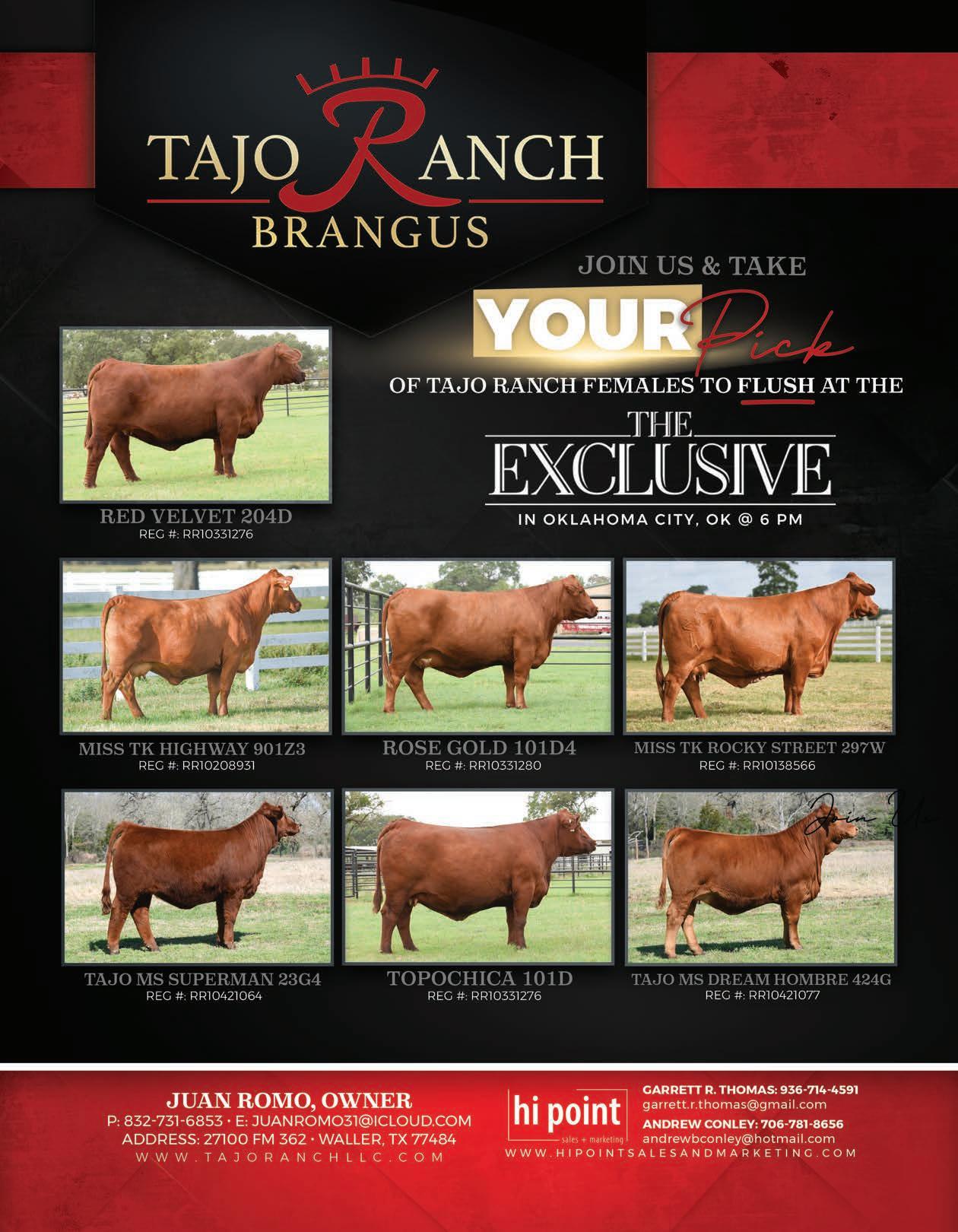
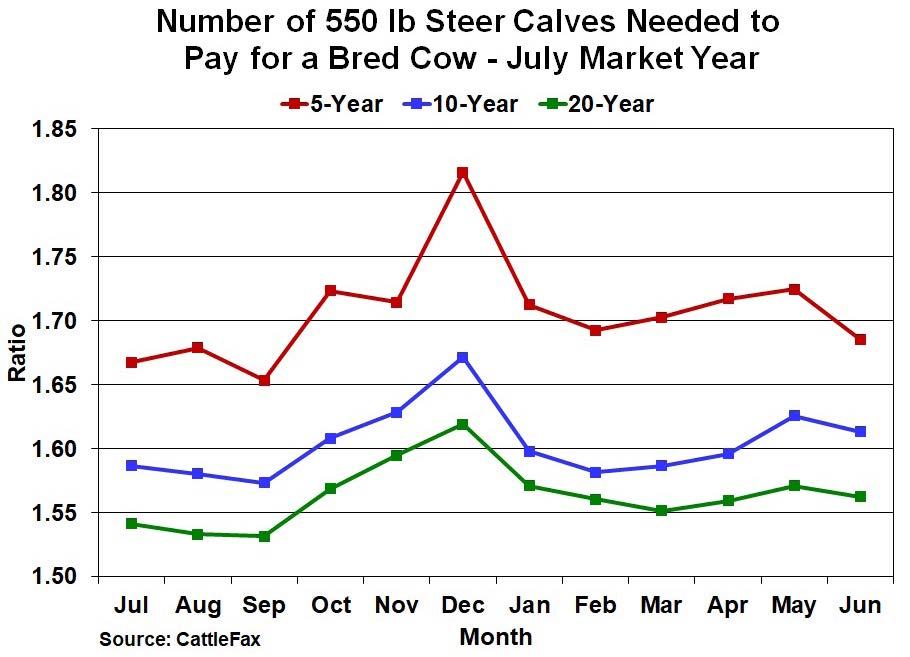
(continued from page 42) article, 2024 calf prices were conservatively projected to average $185/cwt or $1,017 per head. Assuming the ratio is in the same range as the last expansion, 1.64 to 1.76, bred cow prices could average $1,669 to $1,791 per head. It’s likely that $185/cwt in 2024 is too low, or calf prices will continue to trend higher for at least another year or two. For example, if calf values average $200/cwt and using the same ratio range of 1.64 to 1.76, bred fe-males would average $1,804 or $1,936, respectively. As a reminder, U.S. bred cows brought about $2,250 per head, on average, in 2015. Bottom line, no matter how the ratio is calculated or whether it is during contraction or expansion, female prices should not be lower than current levels into the middle of the decade.
Most producers do not buy bred females all year round, so a seasonal measurement can provide some boundaries for bred cow prices relative to the calf market. The accompanying charts display the five, 10, and 20-year average for each month for a July market year. To no surprise the five-year line is the most elevated and shows a slightly different trend between October and November. Nonetheless, December is when the peak occurs for each, after a bottom in September. Because two variables make up a ratio, it is important keep in mind what those seasonals are. Fortunately, the market year seasonal patterns are nearly identical. The bred cow market typically makes a low in September or October before trending to a high around April. Calf prices are usually the lowest in October or November and peak near the end of March. While 2020 has been a challenge, it is also the time of maximum financial opportunity for cow-calf enterprises. Revenue for cowcalf operations is projected to increase into the middle of the decade, but input costs for females are expected to be higher as well. Waiting until the cycle highs, will likely be very expensive and may take several years to pay off. Some learned this lesson the hard way when purchasing cows in 2014 and 2015, because calf prices will not stay at cycle peaks for long, according to history. In fact, this is actually the point of maximum financial risk for a business. If Mother Nature allows, buying females sooner is the right decision for an operation. The current outlook into the middle of the decade suggests the bred cow market should have support near $1,600 per head for a U.S. annual average, with a strong chance of approaching, or even exceeding, $2,000 per head.

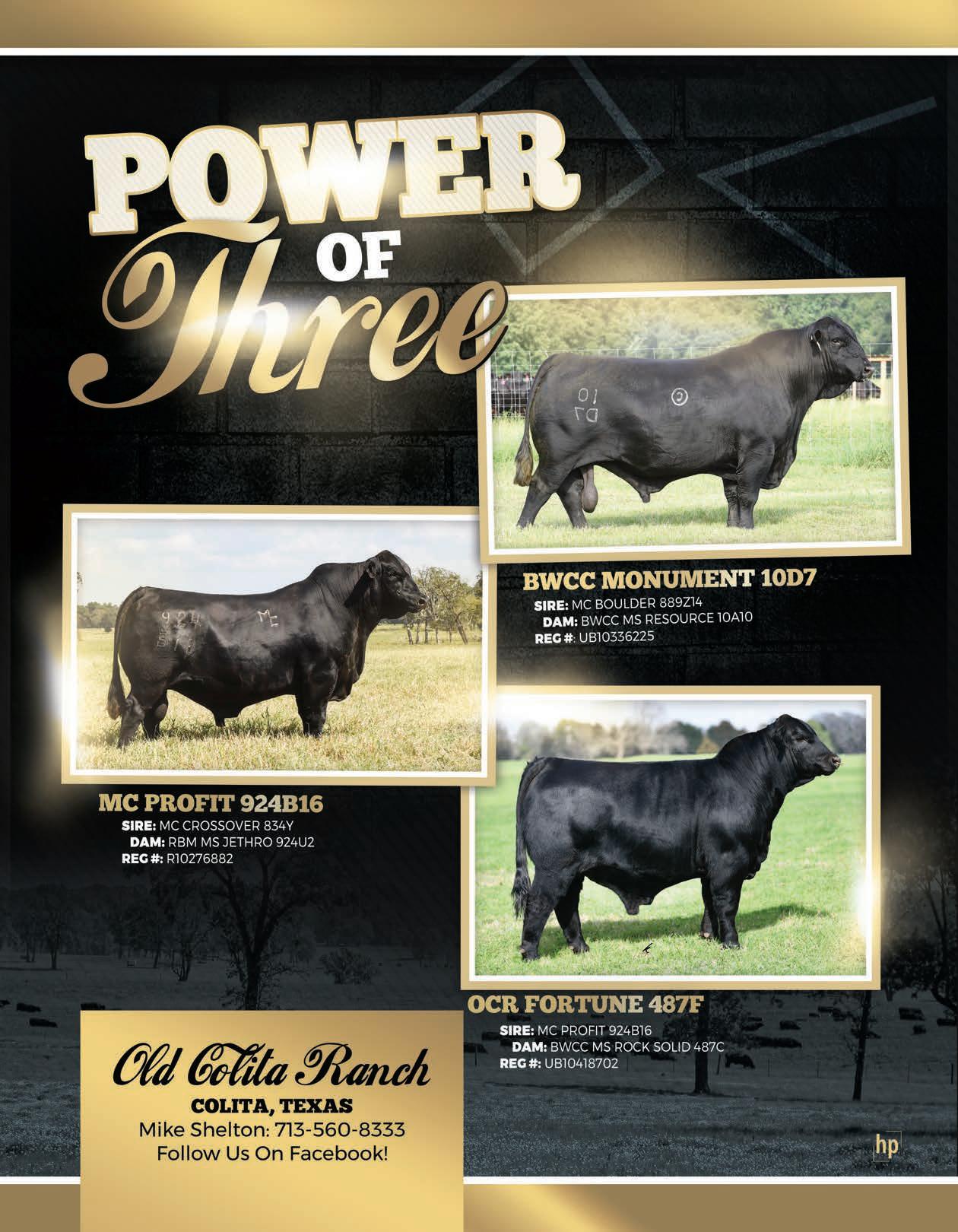


PRESS RELEASE
GENEPLUS AT CHIMNEY ROCK CHALLENGE PEN SHOW
Grand Champion Pen of Two
Lawman Ms Abstract 918H and Lawman Ms Innovation 25H Lawman Brangus Ranch, Okmulgee, Oklahoma Reserve Grand Champion Pen of Two
CFC Miss Big Lake 23H3 and CFC Miss Big Lake 23H Cross F Cattle of Willow City, Texas
An international presence was apparent at the GENEPLUS at Chimney Rock Challenge Pen Show held in Concord, Arkansas, as Palgrove Pastoral Co. P/L of Queensland, Australia swept two divisions at the show held November 6, 2020.
Pat Simmons, Genetic Leaders International, Candler, North Carolina, judged the competitive, high quality show of 31 pens. The show included six Pen of One Brangus, seven Pen of One Ultrablacks, and nine Pen of Two, both Brangus and Ultrablack.
Winning Grand Champion Pen of One in the Brangus division was Palgrove Pastoral Co. with Palgrove Ms LTD Q1611, born November 2019, sired by CB Tradition 63A. RSB Ms Senator 504G4, was named Reserve Grand Champion Pen of One, owned by Rock Springs Farm, Albertville, Alabama. She was sired by Suhn’s HRF Senator 30E80.
Grand Champion in the Ultrablack Pen of One division was an August 2019 female, Ms Palgrove Princess Q780, sired by Suhn’s Business Line 30D26, and owned by Palgrove Pastoral Co. Jackson’s Double J, Gentry, Arkansas, displayed a daughter of Vorel Currency 25E8, JJ Ms Currency 675G, who was named Reserve Grand Champion Pen of One Ultrablack.
Reserve Grand Champion Pen of One
RSB Ms Senator 504G4

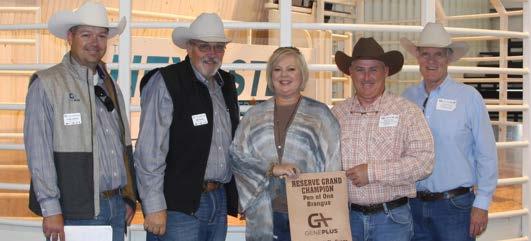
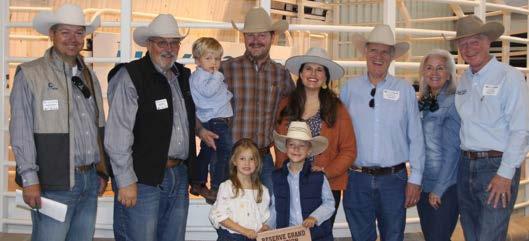
Rock Springs Farm, Albertville, Alabama
Reserve Grand Champion Ultrablack Pen of One
JJ Ms Currency 675G Jackson’s Double J, Gentry, Arkansas
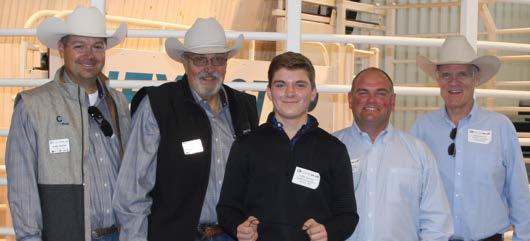
The Pen of Two division combined both Brangus and Ultrablack. Winning Grand Champion Pen of Two was Lawman Brangus Ranch of Okmulgee, Oklahoma, with spring born Ultrablack heifers, Lawman Ms Abstract 918H and Lawman Ms Innovation 25H, sired by Vorel Abstract 25E9 and MAR Innovation 251 respectively. Cross F Cattle of Willow City, Texas, took Reserve Grand Champion honors with two BWCC Big Lake 111F4 daughters, CFC Miss Big Lake 23H3 and CFC Miss Big Lake 23H, Brangus heifers born January 2020.
Exhibitors were entered into a drawing for credit with ReproLogix and $500 from Purina Animal Nutrition. Winning $500 credits with ReproLogix were Wyman Creek Ranch, Summersville, Missouri, Platte Valley Brangus, Burden, Kansas, and Giffin Farm, Rogers, Arkansas. The Purina credit went to Hatfield Brangus, Bentonville, Arkansas.
GENEPLUS hosted this one-of-a-kind pen show as an opportunity for breeders to display their genetics in an innovative format in front of a wide range of their peers. For more information on the GENEPLUS program visit www.GENEPLUSBrangus.com.



GENEPLUS
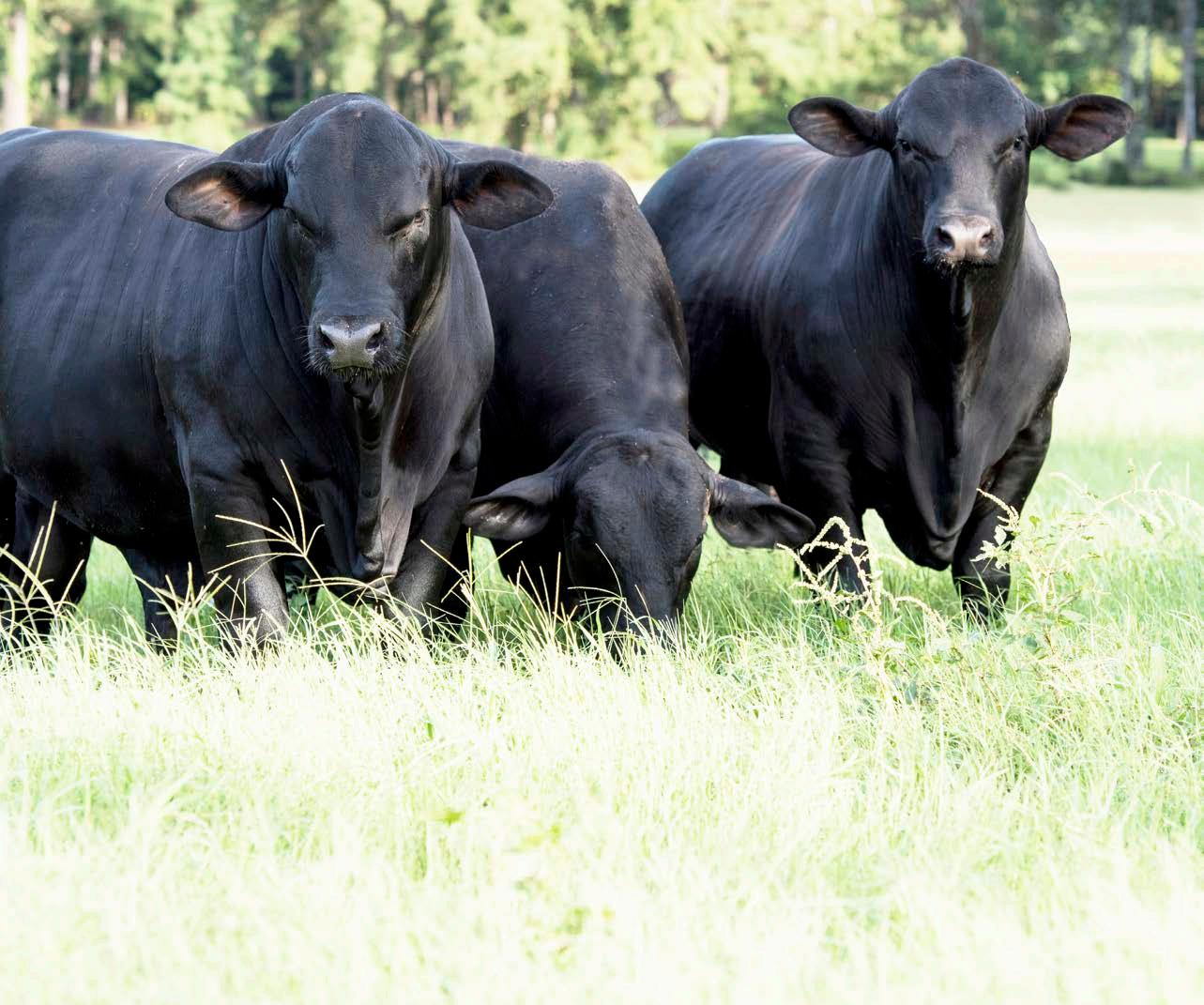

CONVERSATION WITH A Cattlewoman GETTING TO KNOW IBBA BOARD DIRECTOR MARY DOUGLASS OF SEGUIN, TEXAS
WHAT’S THE BEST DAY YOU’VE EVER HAD ON THE OPERATION?
The best day on our farm was when a fellow member and breeder I have known and respected for over 20 years purchased one of my bulls. They were someone who I have always admired the way they evaluate and manage their herd, and someone that has been in the Brangus breed over 40+ years. Finally, after all the work of studying, selecting, culling, and improving my herd, someone who’s opinion was important to me was interested in the Brangus genetics we were producing.
YOU’RE THE BOARD JUNIOR LIAISON, WHY IS THAT IMPORTANT TO YOU?
I love working with junior Brangus breeders! The International Junior Brangus Breeders Association (IJBBA) is a springboard for lifelong friendships. Many of the IJBBA members I met over 20 years ago now have their own children involved as junior members. It is a pleasure to watch these young men and women grow in knowledge, experience, and wisdom while learning roles in leadership, teamwork, and accountability. Plus, the average IBBA member just doesn’t realize how much time and effort goes into the National Junior Brangus Show. Those kids work hard to put on the show and get their cattle there, I’m glad to back them up in support.
WHAT’S THE MOST USED TOOL ON YOUR FARM?
The most used tool on our farm is the elbow grease of Chris and Mary Douglass. But, as far as equipment goes, I’d probably say I use my Kubota RTV more than anything else on the ranch. Followed in third by my computer for most used item.
WHO’S YOUR FAVORITE COW OR BULL?
My favorite cow is CX Ms Presidente 74X1. I sold her dam to Don Cox, Cox Excalibur Brangus at the Texas Brangus Breeders Association (TBBA) Spring Sale in April 2008. Don bred her to SKYHAWK’S Presidente and the mating resulted in 74X1. Some people might say “she’s just a cow.” For me, this cow represents 25 years of memories and cherished friendships. I can look back at her pedigree for five generations, and I personally know almost every breeder, owner, and ranch staff involved in raising her lineage to get her to my ranch. Surveying her pedigree invokes memories of sales, shows, and other events that I have attended with my extended Brangus family.
I am going to proudly stand on their very broad shoulders to produce the best Brangus possible. I’d like to personally thank those who were a part of raising my favorite cow, 74X1.
Don Cox, Cox Excalibur Brangus Russ and Pam Williamson, Skyhawk Brangus Garry and Karen Ishee, D Bar D Brangus David Vaughn, Salacoa Valley Finis Welch, Center Ranch Eric White, South Gate Ranch Tim Lucherk, Rafter L Cattle Brinks Brangus of Camp Cooley Lenis and Keegan Moonen, Moonen Brangus Gene, Nelda, and Woody Ray, Ray’s Brangus Farm Dr. Robert Vineyard, Vineyard Cattle Co. Clayton Williams, Williams Brangus
CX MS PRESIDENTE 74X1

WHAT’S THE MOST IMPORTANT LESSON YOU’VE LEARNED IN THE BUSINESS?
“When a person shows you who they are, believe them the first time.” -Maya Angelou
WHAT’S YOUR FAVORITE/LEAST FAVORITE JOB ON THE FARM?
The worst job on the farm is culling the older cows and bulls from the herd. They’ve done their job and it’s painful to see them leave.
WHAT ABOUT THE FUTURE OF BRANGUS EXCITES YOU THE MOST?
The Brangus breed has come a long way since I bought my first Brangus cattle 25 years ago. Considering the genetic improvements that I have seen over these years, I am looking forward to the prospect of the genetics to come.
TELL US A LITTLE ABOUT YOURSELF.
I believe in Jesus Christ and I hope that he knows me. I am a wife to the best husband, Chris Douglass. I am a mom and a mimi. I am a passionate Brangus enthusiast. I love the smell of the barn. I never tire of planting seeds and watching a crop come up. Spring is my favorite season. I love looking at new baby calves and listening to rain. I like honest hard work and having things done right. I’m a straight shooter; don’t ask me what I think unless you really want my honest opinion. I am not above making a mistake. I like to err on the side of love. I forgive easily and love much.





